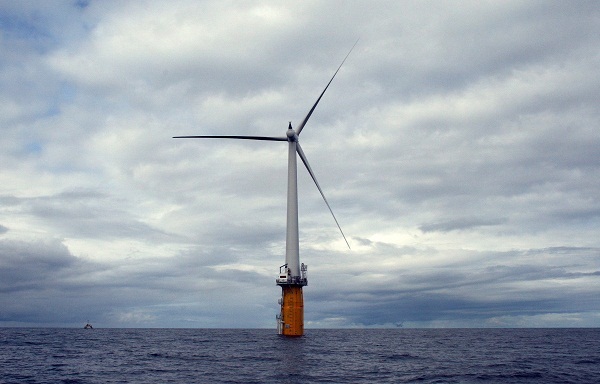Floating wind turbines got a big boost in Maine – and in the United States – on Thursday when the state’s Public Utilities Commission voted 2-1 to approve a contract with global energy developer Statoil for a four-turbine, 12-megawatt pilot project a dozen miles off the coast.
A big part of the promise of the Hywind Maine project is that it will demonstrate the viability of deep-sea wind power technology and spur construction of large offshore wind parks off the Northeast U.S. coast, in the process making Maine a center for design, engineering and manufacturing in the sector.

If all goes well, the demonstration project could be up and cabling electricity to the mainland in 2016.
The commission had leaned 2-1 against the deal in deliberations last October, but gave Statoil a chance to come back with a more attractive term sheet. The company’s revised terms lowered the price of power from the project from $290 per megawatt-hour to $270/MWh. That, along with a strengthened commitment by the company “to involve Maine contractors in any future large wind park it develops prior to 2025 along the Atlantic Coast from Maryland to Maine utilizing the Hywind Maine technology,” was just enough to sway Commission Chairman Thomas Welch to switch from opposing the project to supporting it.
This was no sure thing, as Welch is an appointee of Gov. Paul LePage, whose office has expressed doubts that the Statoil contract complied with the state’s Ocean Energy Act, the law intended to encourage offshore energy development. The cost to ratepayers of the deal – estimated at about 75 cents per month for residential customers – has been a particular concern.
Despite some lingering reservations about the deal, Welch said that it was one that Maine could not pass up.
“Putting Maine on the map as a leader in that effort both in proving the resource and as a center of expertise, has value – enough value, in my view, to tip the balance in favor of concluding that the Statoil proposal, notwithstanding its substantial cost to electricity rate payers, is sufficiently compliant with the Ocean Energy Act to warrant approval,” he said.
Welch noted one other factor in his decision, and it was striking and, to be honest, kind of inspirational to hear him state it. He said:
Maine has struggled to retain its young talent. I think the Maine population is, in fact, close to if not the oldest in the country. There is, I believe, important, though unquantifiable value, in investing in efforts that have the ability to capture the imagination of and generate excitement in the generation of young people who might otherwise seek their paths elsewhere. Projects such as the Statoil proposal, by showing that Maine can be a center for cutting edge development in a field that is often championed by the generation that’s coming, could have a very positive effect on Maine’s demographic and economic future.
Backers of deep water, offshore wind concede its high present costs, but argue that those costs will come down as the technology is tested, implemented and given a chance to evolve. In fact, a project at the University of Maine, which plans to have a prototype turbine deployed some 10 miles off the coast in just a few months, is promising that their turbines will be able to produce electricity at 10 cents per kilowatt-hour ($100/MWh) without subsidies.
Both Maine projects were among seven from around the nation that won seed funding from the U.S. Department of Energy last month. But in an interview with the Kennebec Journal, a Statoil representative had suggested the company was unlikely to go ahead unless it also had state backing for the project. After Thursday’s vote, the rep told the newspaper that the PUC vote “was the biggest hurdle” the project faced.
A video of the PUC’s discussion of the Statoil proposal is available through the PUC website. Click on the “Listen to live audio” button, then find the 1/24/2013 deliberations.